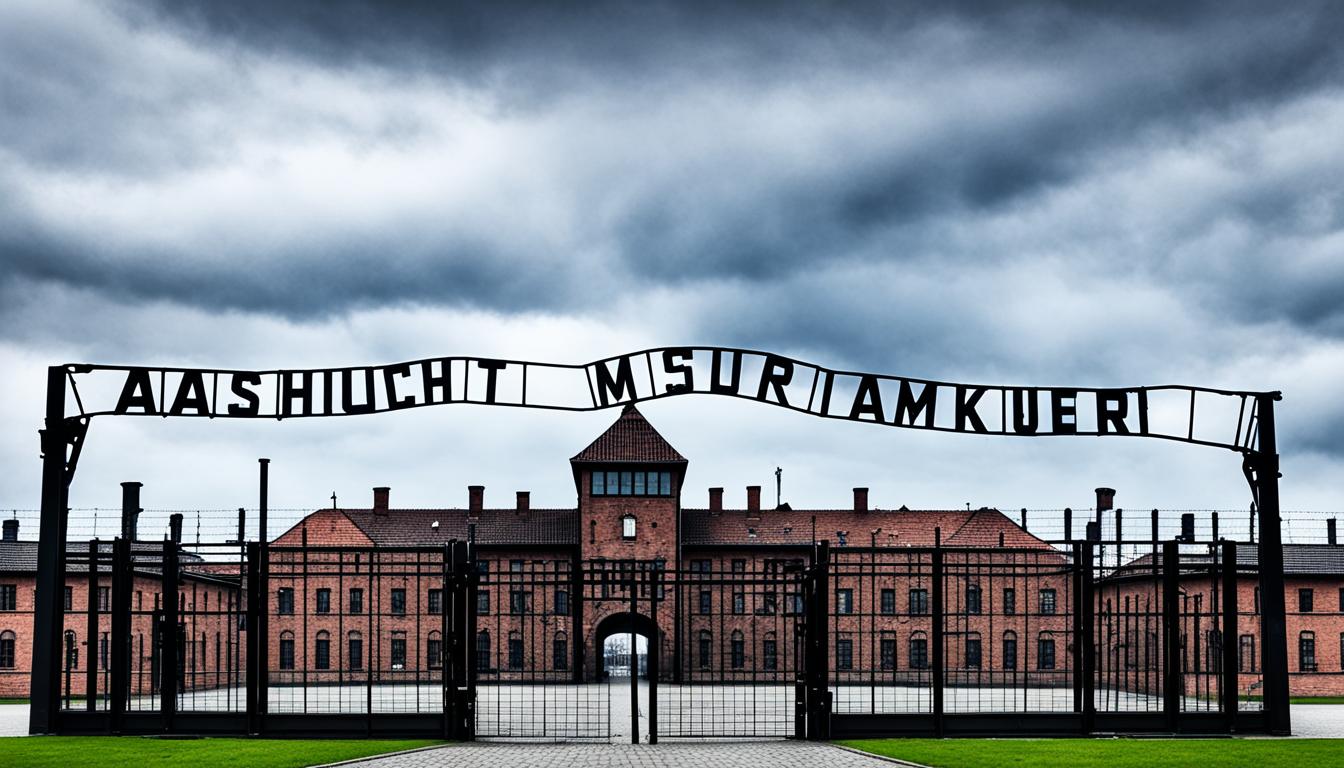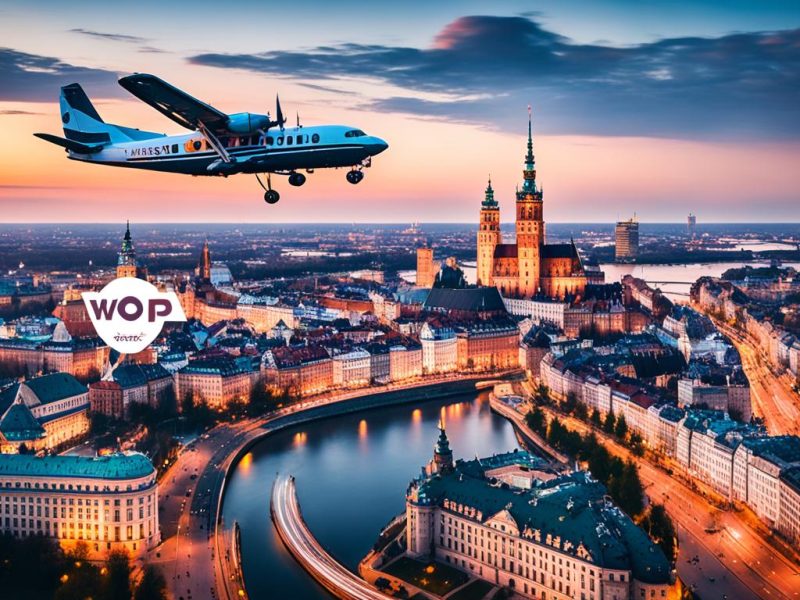In the quiet grounds of Auschwitz Poland, the Auschwitz-Birkenau Memorial and Museum stands. It teaches visitors about the Holocaust’s dark reality and its mark on World War II history. This place was the core of unimaginable horror, telling stories of nearly 1.1 million lives lost within its walls. This guide aims to respectfully cover Auschwitz’s history, its role then, and its lasting impact as a symbol of memory.
Key Takeaways
- Auschwitz serves as a potent symbol of the Holocaust and the lessons it imparts on human history.
- The memorial and museum offer a profound educational experience on the systematic atrocities of the Nazi regime.
- Auschwitz-Birkenau represents the gravest site of mass murder known in history, demanding solemnity and respect from its visitors.
- The preservation of World War II history is crucial in maintaining an informed and vigilant society.
- Remembrance of the victims and recognition of their sufferings is fundamental to the site’s purpose.
- The instructional role of Auschwitz extends beyond the memorial, advocating for a collective responsibility to uphold the truths of the past.
The Harrowing History of Auschwitz
Auschwitz stands as a grim symbol of the Holocaust. It was the site of unimaginable atrocities under Nazi rule. Here, countless lives were lost in the name of the Final Solution, led by Heinrich Himmler.
The memory of those who suffered there is a powerful reminder of the site’s dark past.
The Emergence of Auschwitz as a Concentration Camp
Originally for Polish detainees, Auschwitz soon became a death camp. By Heinrich Himmler’s orders in 1940, it expanded greatly. Jews, Romani people, Soviet POWs, and others were systematically killed there.
The Harrowing Life Inside the Camps
Life in Auschwitz was brutal. Prisoners endured forced labour, starvation, and endless brutality. Survivor stories give us a glimpse into this nightmare. They share the depths of suffering endured.
Elie Wiesel and Primo Levi bring the horrors of Auschwitz to light. Their stories serve as a powerful reminder of the past.
The Auschwitz-Birkenau Memorial and Museum holds items from those who perished. These silent witnesses speak volumes about the tragedy.
Liberation and Its Aftermath
The liberation by Soviet troops unveiled the Holocaust’s horrors. January 27, 1945, marked the end of Auschwitz’s darkest days. It also started the quest for justice through war crime trials.
The trials set a foundation for international human rights law. Auschwitz’s legacy lives on as a UNESCO World Heritage Site. It’s a focus for education and remembrance.
Auschwitz reminds us of our shared history’s darker chapters. It stands as a call to remember and ensure history does not repeat. Its preserved remains and survivors’ voices form a crucial part of our collective memory.
| Auschwitz Camp Phases | Functions and Impact |
|---|---|
| Auschwitz I – The Base Camp | Political imprisonment and death of Polish citizens; a beginning of the Final Solution |
| Auschwitz II-Birkenau – The Extermination Site | Mass genocide with gas chambers and crematoria; major site for the Jewish Holocaust |
| Auschwitz III-Monowitz – The Labour Camp | Forced labour for industrial works, notably for IG Farben; pervasive inhumane conditions |
| Subcamps & Commandos | Scattered sites of varied forced labour tasks, supplementing the larger Auschwitz goals |
Visiting Auschwitz Poland: Reflecting on the Past
A visit to Auschwitz Poland is a deep dive into history, far beyond just looking around. Those who join the Auschwitz tours embark on a meaningful journey. They go back to a time during World War II that we all promise never to let happen again. Walking through the ‘Arbeit Macht Frei’ gate and past the barracks takes you back in history. The sight of the ruined gas chambers is heartbreaking. These tours teach us a lot about the past in a very direct way.
When we visit Auschwitz, showing respect is key. The place saw so much suffering; it’s only right to approach it with care and deep reflection. The goal is to respectfully remember those who died or suffered there. The site offers educational programs in many languages. This helps everyone learn and remember the history together.
Auschwitz is a reminder of what happened when hate and indifference won. But it’s also a place that teaches us about the importance of remembering history. It tells us we must understand the past to prevent such horrors from happening again. When visitors leave, they carry a strong message: We must remember this cruelty to prevent it. Auschwitz helps us see why we must always watch out for hatred and work to stop it.
FAQ
What is the historical significance of Auschwitz?
Auschwitz in Poland is a stark reminder of extreme tragedy. It highlights the Holocaust’s horrors during World War II. Established by Nazis, it stands for the crimes against many people there.
How did Auschwitz evolve into a network of camps?
Auschwitz started as one camp in 1940 for Polish political prisoners. Later, it grew into several camps under Heinrich Himmler’s orders. This included Auschwitz II-Birkenau for mass killings and Auschwitz III-Monowitz, a labor camp.
Can visitors tour Auschwitz today?
Yes, you can visit Auschwitz-Birkenau and its museum today. Visitors can join guided tours. These tours offer insights into how the camp worked, showing places like the ‘Arbeit Macht Frei’ gate and the remains of gas chambers.
What conditions did prisoners face in Auschwitz?
Prisoners faced terrible living conditions. They dealt with crowding, little food, hard labor, and harsh treatment. Stories from survivors like Elie Wiesel and Primo Levi share these difficult experiences.
What is the significance of January 27, 1945, in Auschwitz’s history?
January 27, 1945, marks the day Soviet troops freed Auschwitz. This revealed the camp’s dreadful events. It’s now International Holocaust Remembrance Day, to remember the victims and teach about the Holocaust.
What lessons can be learned from visiting Auschwitz?
A visit to Auschwitz teaches about human cruelty and the value of memory. It highlights the Holocaust, talks about human rights, and stresses preventing such horrors again.
How are the stories of Auschwitz victims preserved?
The tales of those at Auschwitz live on through displayed artifacts and personal items. These, along with educational materials, help share the stories of those who suffered there.
Why is Auschwitz included on the UNESCO World Heritage List?
UNESCO listed Auschwitz in 1979 to honor its educational and memorial importance. It helps teach about the Holocaust, urging us to remember and stay aware.
What principles should guide visitors when touring Auschwitz?
When visiting Auschwitz, respect and deep thoughtfulness are key. Following ethical tourism ideas helps keep the history and lessons of Auschwitz alive for the future.
Which personal accounts from Auschwitz survivors have shaped our understanding of the Holocaust?
Stories from Auschwitz survivors like Elie Wiesel’s “Night” and Primo Levi’s “If This Is a Man” deeply influence our Holocaust view. Their stories offer a glimpse into the struggle and strength of those in the camps.



